A PHOTOGRAPHIC CHRONOLOGY OF THE VIOLENCE ON BARALT AVENUE.
La versión en español está aquí.
FIRST PHOTOS: Approximately 2:15 in the afternoon, April 11.
An amazing amount of information can be gleened from these first two photographs. Take a close look. If you need to orient yourself, you may want to look at this street diagram. Click on the image if you prefer to see it in a single browser window.
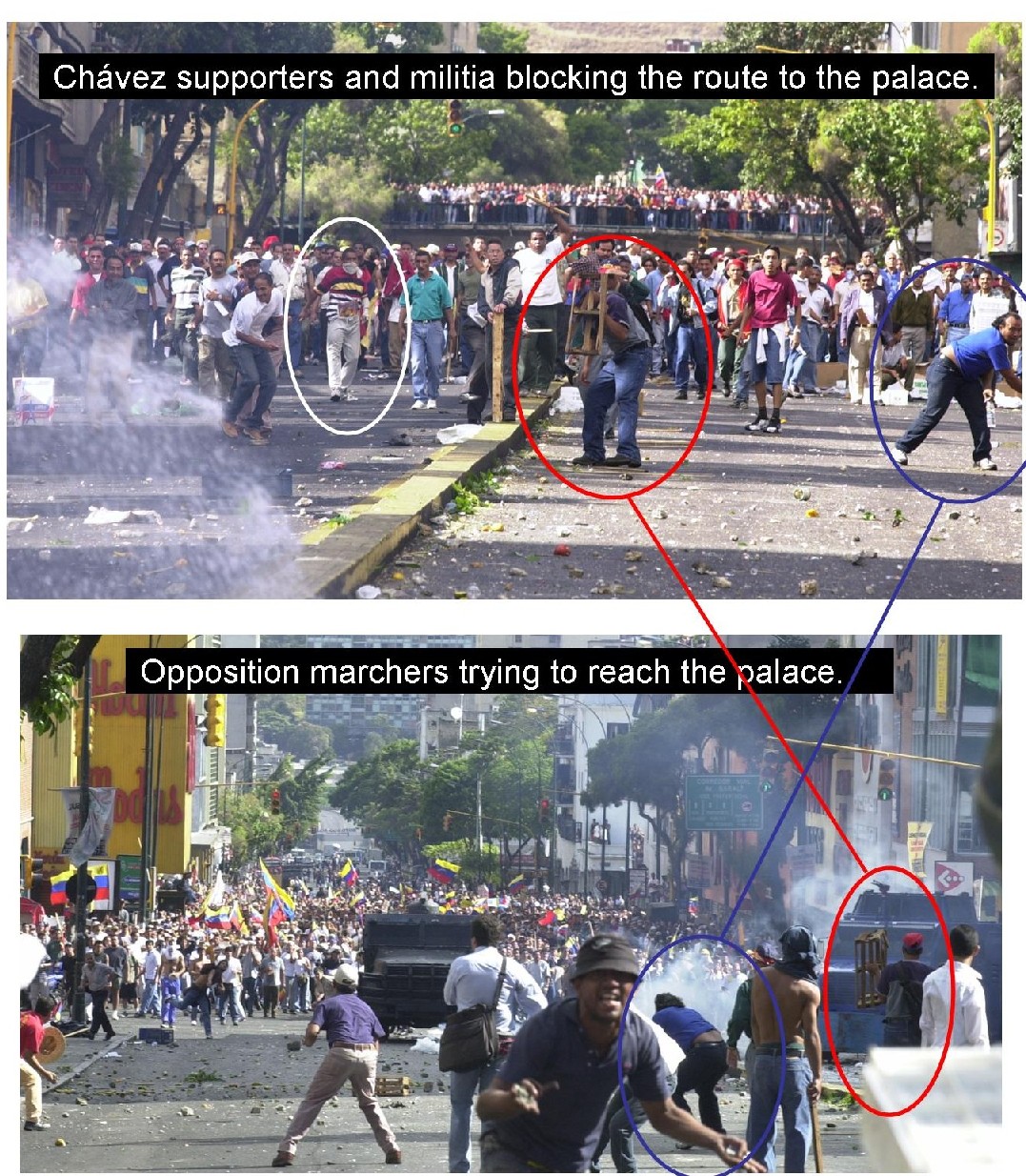
As you can see, the two photos were taken at almost the same instant, but from opposite sides of the confrontation. In fact, we can see the same individuals in both pictures, standing in the same spots. This gives us an excellent 360 degree snapshot of the confrontation.
What do these pictures tell us?
1. We know that it is very early in the afternoon because the two groups are still very close together (literally a stone's throw). As the afternoon wore on and as the violence escalated, the marchers and the Chávez loyalists moved farther and farther apart, with the police in the middle. We also know that it is early because there are only two police trucks in the lower image. The police would be reinforced with two more trucks after they realized the gravity of the situation.
2. We can see the Llaguno Overpass clearly in the top picture. This is the overpass where the pro-Chávez gunmen will be shooting later in the afternoon (about two hours from now). These two photographs alone prove that the documentary film The Revolution Will Not Be Televised was lying when it claimed that the pro-Chávez gunmen were not shooting at anyone because the street below was empty and that the march had not come this way.
3. These two photographs also establish the distance between the Llaguno Overpass and the marchers. Do you think that gunmen shooting from the bridge could have killed or injured someone in the march from that distance? If you answered yes, then you should know that the Venezuelan government disagrees with you; they insist that it is too far away.
Finally, remember the man in the muli-colored shirt who I have circled in white in the top photo. You will be seeing him again very soon.
SECOND PHOTOS: THE FIRST SHOOTINGS — Just before 2:30 p.m.
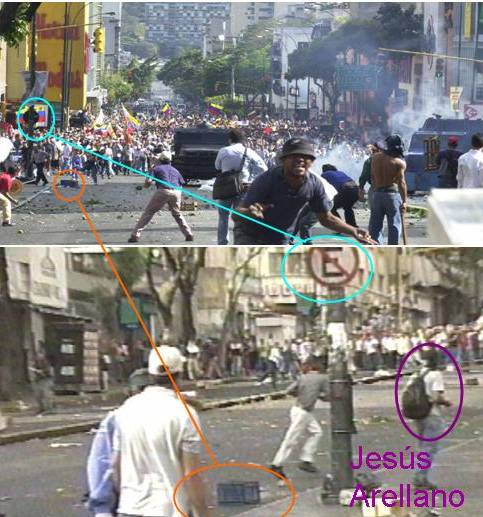
The first fatality of the day came when a gunman in the pro-Chávez crowd shot and killed Jesús Arellano, an anti-Chávez marcher on the Pedrera intersection of Baralt Avenue. To watch the footage of this killing, click here.
A few minutes later, photographer Jorge Tortoza was also hit by a bullet from the pro-Chávez crowd just a few feet from where Jesús Arellano was hit. A few seconds later, Malvina Pesate was hit. To view footage of these shootings, click here.
THIRD PHOTOS: THE WIDENING GAP — Between 2:45 and 4:30 p.m.
In response to the first shootings, the Metropolitan Police put themselves between the two groups. This helped to protect the marchers from the gunmen, but the gunmen--feeling that the police were attacking them and trying to help the march--turned their guns increasingly on the police.
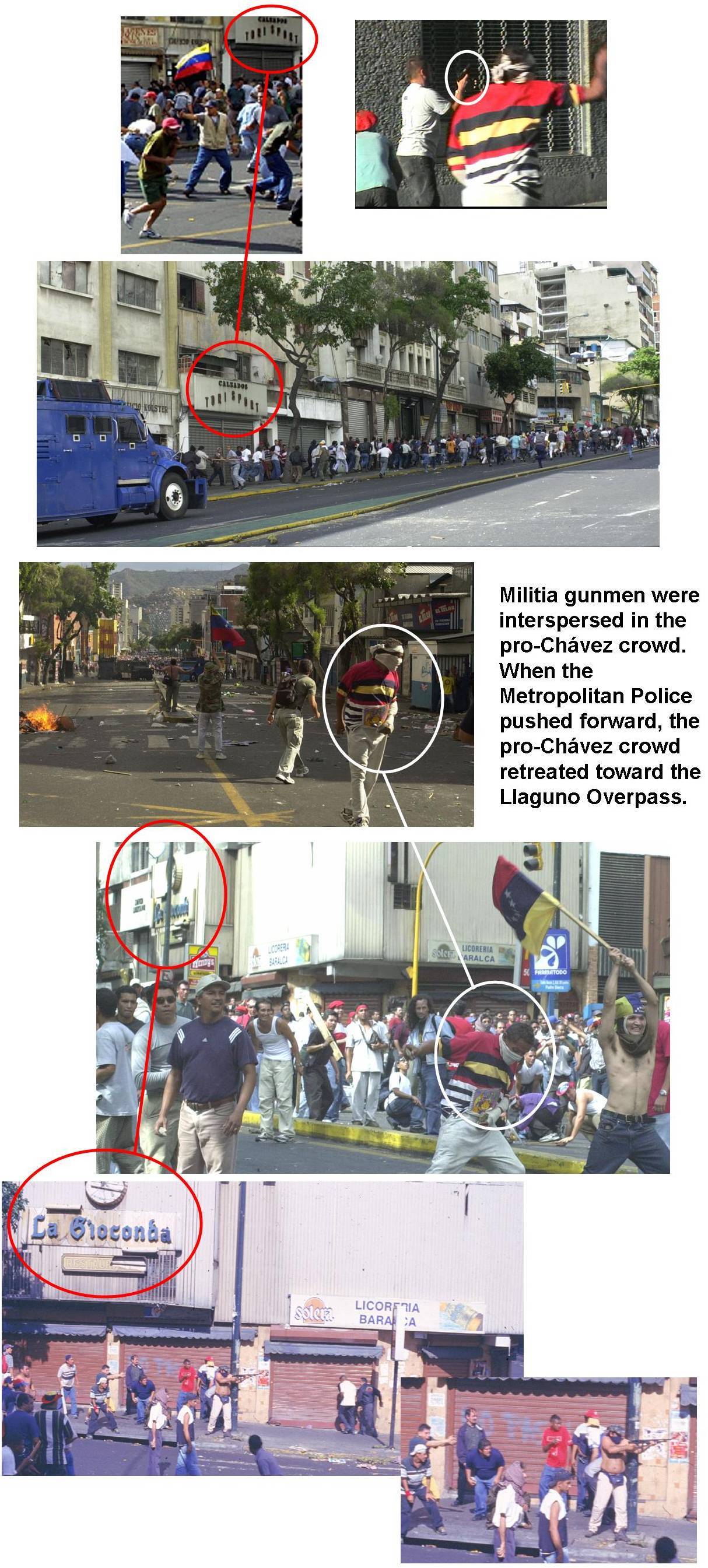
Notice that the Chávez supporter in the multi-colored shirt (who I pointed out in the very first picture) appears in three of these photographs. Also note that there are three police trucks in the street now instead of two. Finally, you can see that the Chávez supporters and gunmen have moved farther and farther up the street (North) as the police advanced.
FOURTH PHOTOS: Just before 4:30 p.m.
By this hour there is significantly more distance between the pro-Chávez and the anti-Chávez groups. However, the intense gunfire that would soon erupt from the Llaguno Overpass (in the background of the top picture) has not yet begun. We know this because there are still a lot of Chávez supporters standing there. Most would flee when the gunfire picked up.
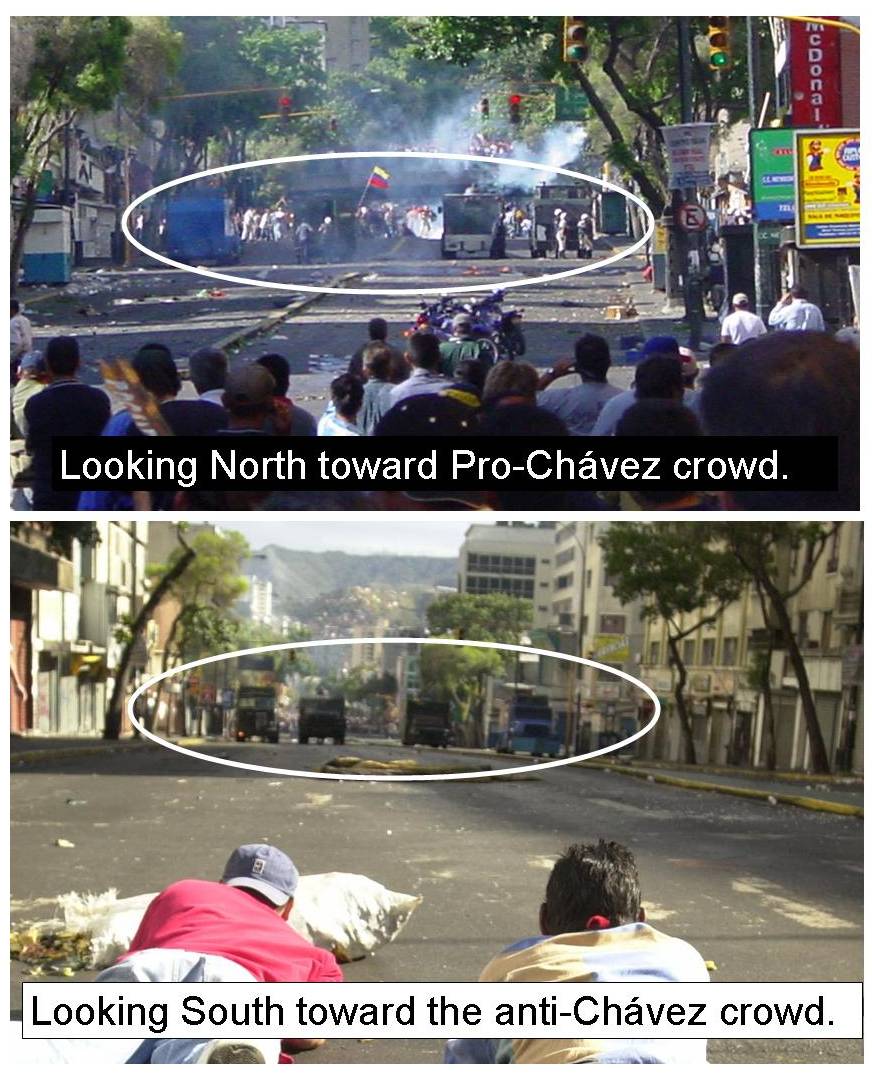
Note that the top picture was probably taken a little earlier than the bottom picture, as there are less people below the overpass in the bottom shot. And, yes, I do believe that the man in the center of the top picture is the man with the multi-colored shirt.
FIFTH PHOTOGRAPHS: THE PUENTE LLAGUNO GUNMEN — 4:35 p.m.
At about 4:35 (4:37 according to Hugo Chávez), gunmen on the Llaguno Overpass began firing down Baralt Avenue. Given the distance that was between the march and the bridge, most of their gunfire was likely focussed on the police, but we cannot say for sure. By now the police had been reinforced with SWAT-type units that included sharpshooters. As I have written previously, in a gun battle between police sharpshooters (with rifles) and poorly trained civilians (with pistols), the pro-Chávez gunmen were tragically outgunned. These sharpshooters shot several of the gunmen and likely hit unarmed bystanders, too.
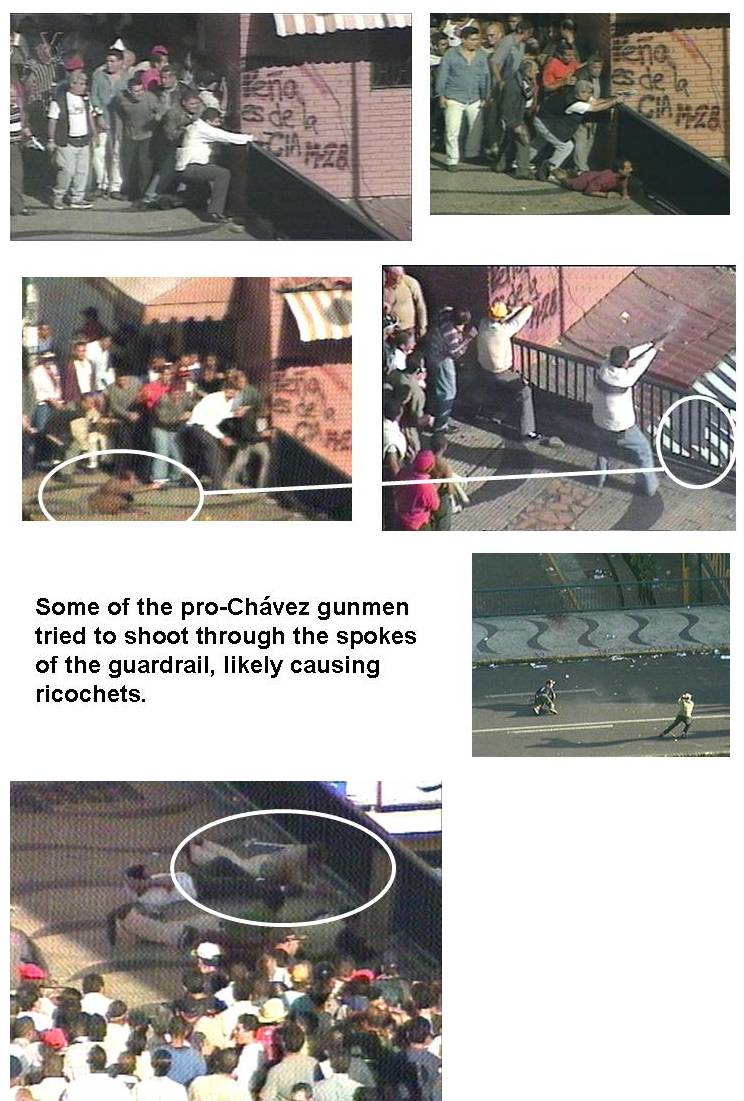
The man circled on the last photo is Erasmo Sánchez. He was firing toward the police on the West side of the Llaguno Overpass when he was shot in the face, most likely be a police sharpshooter. According to my research, he is the first pro-Chávez fatality of the day, occuring at about 4:45 p.m. More than two hours after the first anti-Chávez victim was killed.
The shooting of Erasmo Sánchez was not caught on video, but there is video of him being carried to the medical tents across from the palace of Miraflores. (For larger .wmv format, click here.) Sánchez was shot through the right cheek and the bullet exited out his neck. I bring this up because these wounds fueled speculation that there were snipers shooting people from the surrounding buildings. That is, if you didn't know that Sánchez was lying on his stomach when he was shot (and assumed he had been standing) it would appear that he had been shot from above. While I cannot say with complete certainty that there were no snipers in this area, there is no video or photographic evidence of them. What's more, on close inspection, just about all of the deaths can be traced to bullets fired by the police or the pro-Chávez gunmen.
SIXTH PHOTOGRAPHS: FINAL SHOTS — After 5:30 p.m.
After 5:30 the gunfire died down. The march had turned back, there were only one or two gunmen still on the overpass, and the police began to withdraw.
It was at this point that the film The Revolution Will Not Be Televised showed an image of a mostly abandoned Baralt Avenue and declared the following: “What the networks didn’t show was this shot in which it is clearly shown that the street below was empty. The opposition march had not taken this route. They used the images of the people shooting to say that the chavistas had shot at the demonstrators and with that manipulation Chávez was blamed for the deaths.”
The only problem for the filmmakers was that even at this late hour the street wasn’t quite empty—so the filmmakers put a black bar at the top of the frame to hide the last Metropolitan Police truck that were still there.
| Footage from The Revolution Will Not Be Televised |
Original footage with police truck at top of frame. |
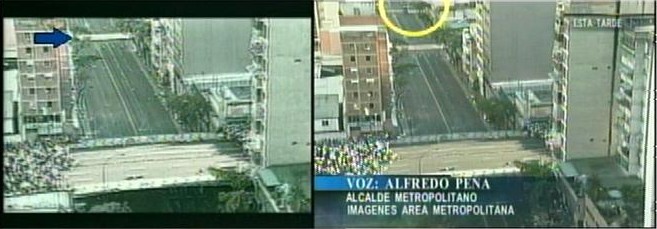 |
To view a two-part video presentation of this manipulation, click here:
Part 1 - Manipulation of footage in The Revolution Will Not Be Televised
Part 2 - Manipulation of footage in The Revolution Will Not Be Televised
To view all the manipulations of The Revolution Will Not Be Televised, watch the documentary film X-Ray of a Lie.
Where do you want to go?
|
